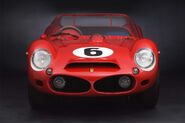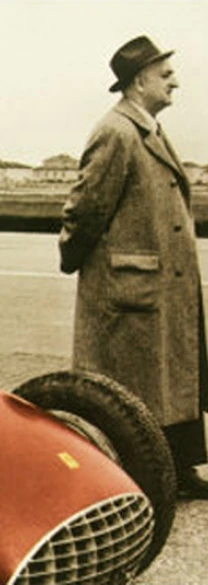
| |
| Ferrari 330 TRI/LM | |
|---|---|
| Race Car | |
| Category | Race Cars |
| Constructor | Ferrari |
| Designer | Designer (lead designer if it was a team effort) |
| Predecessor | {{{Predecessor}}} |
| Successor | {{{Successor}}} |
| Chassis | |
| Suspension (front) | |
| Suspension (rear) | |
| Engine | V12 |
| Electric_motor | {{{Electric motor}}} |
| Battery | {{{Battery}}} |
| Power | {{{Power}}} |
| Transmission | |
| Weight | {{{Weight}}} |
| Fuel | |
| Brakes | {{{Brakes}}} |
| Tyres | |
| Notable entrants | |
| Notable drivers | |
| Debut | pending (if not yet introduced) |
| Races competed | |
| Race victories | |
| Podiums | {{{Podiums}}} |
| Constructors' Championships | |
| Drivers' Championships | |
| Pole positions | |
| Fastest laps | |
The Ferrari 330 TRI/LM Spyder (chassis number 0808) is a unique racing sports car purpose-built in 1962 by Ferrari to achieve victory at the 24 Hours of Le Mans. It was the last Ferrari racing sports car with a front-mounted engine and the last of a series of Ferrari race cars known as the Testa Rossas. The "I" in its designation indicates that the car has an independent rear suspension (indipendente in Italian).
Background[]
The Testa Rossa family began in 1956 with a customer request for a two-liter, four-cylinder sports car capable of defeating arch-rival Maserati's 200 S. This resulted in the creation of the 500 TR, a two-seater spider with engine and suspension based on the Tipo 500 Formula Two car. The 500 TR first raced at the 1956 1000 km Monza, where Peter Collins and Mike Hawthorn took it to its maiden win, with 500 TRs also placing 2nd and 4th.
The unlimited-displacement class of the World Sportscar Championship was ended in response to the accident at the 1957 Mille Miglia, as the ruling bodies of motor racing attempted to make racing safer by reducing engine power and thus overall speed. The World Sportscar Championship then imposed a three-liter displacement limit, which Ferrari supported to accommodate American racer-customers. In response, Ferrari developed the 1957 250 TR, based on the 500 TR chassis but now powered by a highly tuned version of the 250 series Colombo-designed V12. The 250 TR achieved great racing success from 1957 though 1961, although by the end of the 1961 season the 3 liter engine and front-engine, rear-wheel-drive chassis were showing their age. The 330 TRI/LM was the final development of the Testa Rossa platform, before mid-engined cars such as the 250 P took over this racing category.
Racing history[]
Beginning in 1960 as a 250 TRI/60 Fantuzzi Spyder (chassis 0780TR), the car was badly damaged in a crash during a practice session for the 1960 Targa Florio road race (its debut). It was rebuilt, failing to finish at the 1960 24 Hours of Le Mans then finishing second at the 1961 12 Hours of Sebring, before being damaged again in its second Targa Florio outing. After finishing second at the 1961 Nürburgring 1000km and 1961 24 Hours of Le Mans, it won at the 1961 Pescara 4 Hours.
Following Pescara, regulatory changes allowed Ferrari to rebuild 0780TR into its final form as the 330 TRI/LM (chassis 0808), with a larger 4.0 liter V12 engine and a new body. The 330 TRI/LM won the 1962 24 Hours of Le Mans, the last front-engine car to win the race. It was then sold to Luigi Chinetti's NART, competing in North America with some success before returning to the 1963 24 Hours of Le Mans. The car was running in third place into the night against newer, factory-mid-engine Ferrari prototypes when it crashed and dropped out of the race.
The 330 TRI/LM's racing career ended after the 1963 24 Hours of Le Mans and it was subsequently repaired and rebuilt as a road car. Since then, it has been owned by several different collectors and restored back to 1962 specification. The car most recently sold to Gregorio Pérez Companc, who paid €7,000,000 in 2007.
Ferrari had dominated sports-car racing since 1958, with three World Sportscar Championships and three 24 Hours of Le Mansvictories in four attempts. In 1962, the CSI (Commission Sportive Internationale) and ACO (Automobile Club de l'Ouest) restructured their rules and classifications to emphasize GT cars and make the three-litre sports-racing class (dominated by cars like the 250 TR) obsolete. The displacement limit for GT cars and the new experimental class was raised to four litres. At this time, Ferrari replaced its sports racers with mid-engine designs and V6s or V8s and decided to rebuild chassis 0780TR as the 330 TRI/LM for the experimental class. This chassis was to be the only 330 TRI/LM ever built.
The transformation of 250 TRI60 0780TR to the 330 TRI/LM involved significant changes to the engine, body and chassis. The 3 liter 250 series engine was replaced by a Tipo 163 4-litre Colombo V12 with free-breathing cylinder heads, larger valves, six twin-barrel Weber 42DCN carburetors and dry sump lubrication. This engine provided 390 horsepower (290 kW) at 7500 rpm, 50 bhp more than the 250 TR and with a power/displacement ratio of almost 100 hp/liter. The five-speed transaxle was modified with strengthened gears to handle the additional power. The new 4-liter V12 was 4 inches (10 cm) longer than the 250TR's 3-litre Colombo engine, necessitating a new chassis frame to suit the engine and to comply with the new regulations. The frame was 6.3 centimetres (2.5 in) longer to the 250 TR's for better balance, strengthened to accommodate the increased power and torque and accommodated the TRI/61's independent coil-spring suspension system. The transformation was completed with a new body by Fantuzzi with aerodynamic roll hoop as well as a new chassis number, 0808.
Gallery[]
330 TRI/LM[]
330 LMB[]
Complete Racing Results[]
(key) (results in bold indicate pole position)
| Year | Team | Engine | Tyres | Drivers | 1 | 2 | 3 | 4 | 5 | 6 | 7 | 8 | 9 | 10 | 11 | 12 | 13 | 14 | 15 | 16 | 17 | Points | WCC |
|---|---|---|---|---|---|---|---|---|---|---|---|---|---|---|---|---|---|---|---|---|---|---|---|
| YYYY | (Constructor) | (Engine) | (Tyre code) | ||||||||||||||||||||
Notes and references[]
See Also[]









